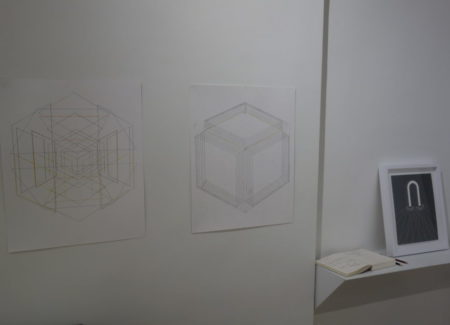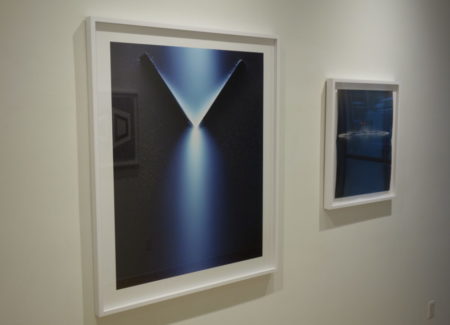JTF (just the facts): A total of 16 black and white and color works, framed in white and unmatted, and hung against white walls in the single room gallery space. 13 of the works are photograms on gelatin silver paper, made in 2015 and 2016. These works are sized 10×8, 14×11, 20×16, or 24×20, and are unique. The other 3 works are archival inkjet prints, made in 2014 or 2015. These prints are each sized 40×32 and are available in editions of 3. The show also includes two of the artist’s paper templates. (Installation shots below.)
Comments/Context: Photography hasn’t always been as easy and instantaneous as it is today. For most of its history, and largely irrespective of which particular technology was in ascendance at any one moment, it’s been an art form rooted in painstaking technical detail, anchored by chemistries and calculations that have required attentive management to generate the desired results. Part of what is slowly disappearing (or at least changing) in our digital age of photography is this process-centric labor intensiveness, this non-negotiable investment of time and effort, where hours of trial and error in the darkroom are intimately tied to masterful artistic outcomes. As darkrooms become increasingly obsolete, the creative alchemy of the time spent in the thin red light is also disappearing, and with it, the methodical almost meditative engagement with the medium that often formed the basis for artistic inspiration.
And for every trend like the one above, there are of course exceptions. Caleb Charland is a darkroom holdout. His newest images were made with workman-like dedication, day after day, month after month in the darkroom, experimenting and iterating, building up ideas until something finally converges and a perfect example of the underlying idea can be executed. Each work is an exercise in photographic science, deliberately testing the properties and limits of light. Seen together, his show is evidence of a relentlessly curious mind, always in search to new ways to push the limits of what can be captured on light sensitive paper.
Crisp geometries dominate several of Charland’s new works. One pair plays with the illusionistic paradox of a rectangular box (is it folding in or folding out?), with stripes running from white to black decorating the sides. Each different monochrome shade requires a discrete exposure setting, the masking off of certain areas done with exacting precision to generate the perfect alignments and proportions. A second pair creates the appearance of boxes exploding from the inside, with square panes radiating outward and transparent nested cubes expanding with brightness. The pencil line templates for these works are shown on an adjacent wall, showing just how detailed the many-step process is to create just one print.
Other new works explore alternate paths. Trapezoidal patterns and semicircular rounds are made on one half of a folded page and then used as paper negatives on the other half. A large horseshoe magnet attracts nails and taut strings in elemental white on black. And various circular forms become radiant dark star penumbras and serial moon phase diagrams, all within the confines of the photogram process.
Phosphorescent particles (i.e. absorbing and re-emitting light) provide Charland with yet another vehicle for experimentation. The white dust is poured though an angled slit, creating a hazy luminescent wave that falls from top to bottom. A cylinder seems to bubble over in bright orange light, dripping up and down the sides in both directions. And an extended cord snaps back, throwing the whiteness off like flour in a bake shop.
All of this adds up to a mental picture of Charland constantly experimenting, the hours likely passing in instants as he becomes entirely absorbed and engrossed by the artistic problems on his darkroom table. A final image made while lying on the ground, his camera siting on his chest and pointed at the night sky, captures this quiet, persistent patience – as his chest rose and fell (from breathing), the white stars shimmered in lengthening tendrils and passing airplanes left behind lines of red dots like Morse code in the night. As an artwork, it’s emblematic of Charland’s throwback approach – there is surprising magic to be found when we diligently embrace science and let it reveal its tangled mysteries.
Collector’s POV: The works in this show are priced as follows. The black and white photograms are $2000, $2600, $3200, or $4000 based on size, while the larger color prints are $5000 each. Charland’s work has little secondary market history at this point, so gallery retail remains the best option for those collectors interested in following up.













